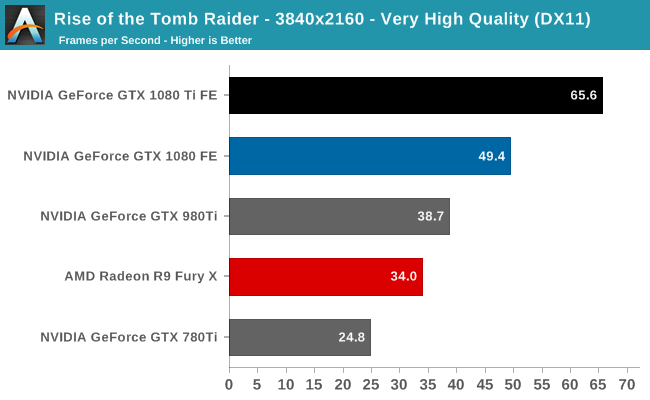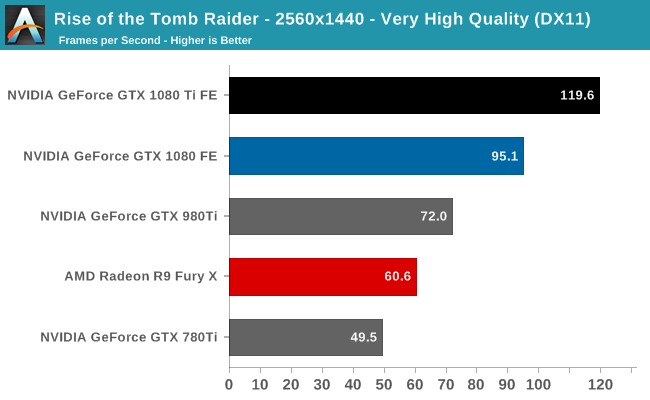The NVIDIA GeForce GTX 1080 Ti Founder's Edition Review: Bigger Pascal for Better Performance
by Ryan Smith on March 9, 2017 9:00 AM ESTRise of the Tomb Raider
Starting things off in our benchmark suite is the built-in benchmark for Rise of the Tomb Raider, the latest iteration in the long-running action-adventure gaming series. One of the unique aspects of this benchmark is that it’s actually the average of 4 sub-benchmarks that fly through different environments, which keeps the benchmark from being too weighted towards a GPU’s performance characteristics under any one scene.


As we’re looking at the highest of high-end cards here, the performance comparisons are pretty straightforward. There’s the GTX 1080 Ti versus the GTX 1080, and then for owners with older cards looking for an upgrade, there’s the GTX 1080 Ti versus the GTX 980 Ti and GTX 780 Ti. It goes without saying that the GTX 1080 Ti is the fastest card that is (or tomorrow will be) on the market, so the only outstanding question is just how much faster NVIDIA’s latest card really is.
As you’d expect, the GTX 1080 Ti’s performance lead is dependent in part on the resolution tested. The higher the resolution the more GPU-bound a game is, and the more opportunity there is for the card to stretch its 3GB advantage in VRAM. In the case of Tomb Raider, the GTX 1080 Ti ends up being 33% faster than the GTX 1080 at 4K, and 26% faster at 1440p.
Otherwise against the 28nm GTX 980 Ti and GTX 780 Ti, the performance gains become very large very quickly. The GTX 1080 Ti holds a 70% lead over the GTX 980 here at 4K, and it’s a full 2.6x faster than the GTX 780 Ti. The end result is that whereas the GTX 980 Ti was the first card to crack 30fps at 4K on Tomb Raider, the GTX 1080 Ti is the first card that can actually average 60fps or better.










161 Comments
View All Comments
ryvoth - Thursday, March 9, 2017 - link
Solid card release from NVIDIA too bad our costs in Canada suck due to the dollar.mapesdhs - Saturday, March 11, 2017 - link
Ditto the UK. Sites keep mentioning an RRP of $700, but in the UK it's the equivalent of more like $900+.Meteor2 - Tuesday, March 14, 2017 - link
Don't forget the US doesn't have VAT. Or a NHS.Mr Perfect - Thursday, March 9, 2017 - link
Wait, so Pascal is going to have a two year lifecycle as-is? There won't be a refinement cycle like Fermi to Kepler? That's a little disappointing.Ryan Smith - Thursday, March 9, 2017 - link
Fermi technically had a 2-year lifecycle. The only reason it was special is because the original silicon had issues, and NV opted to fix it.There are still yearly product refreshes, but GPUs are too expensive to develop (and the underlying manufacturing process too slow to advance) to do top-to-bottom new GPUs every single year.
supcaj - Thursday, March 9, 2017 - link
Disappointed to STILL not see ANY VR-related benchmarks in the suite. VR rendering has unique rendering requirements, and a huge margin of gamers have moved or are planning to move to VR during the lifetime of this card.r3loaded - Thursday, March 9, 2017 - link
Hey, 'member when top-tier GPUs costed $499? I 'member!eddman - Thursday, March 9, 2017 - link
http://i.imgur.com/pGKlskP.pngMr Perfect - Thursday, March 9, 2017 - link
I'd love to see how that compares father back, adjusted for inflation. My rose tinted goggles have me remembering top-tier GPUs launching for $400 or less back in the early 2000s, but who knows how that compares to 2017 dollars.eddman - Friday, March 10, 2017 - link
http://i.imgur.com/OU6612c.pngThere are a lot of inflation calculators online. Like this: https://www.bls.gov/data/inflation_calculator.htm
A geforce 2 ultra was $705 in 2017 dollars!